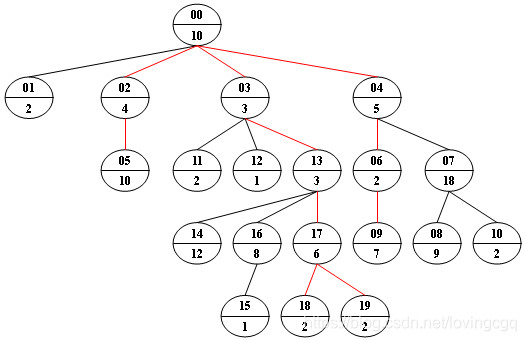Given a non-empty tree with root R, and with weight Wi assigned to each tree node Ti . The weight of a path from R to L is defined to be the sum of the weights of all the nodes along the path from R to any leaf node L.
Now given any weighted tree, you are supposed to find all the paths with their weights equal to a given number. For example, let’s consider the tree showed in the following figure: for each node, the upper number is the node ID which is a two-digit number, and the lower number is the weight of that node. Suppose that the given number is 24, then there exists 4 different paths which have the same given weight: {10 5 2 7}, {10 4 10}, {10 3 3 6 2} and {10 3 3 6 2}, which correspond to the red edges in the figure.

Input Specification:
Each input file contains one test case. Each case starts with a line containing 0<N≤100, the number of nodes in a tree, M (<N), the number of non-leaf nodes, and 0<S<230, the given weight number. The next line contains N positive numbers where Wi(<1000) corresponds to the tree node Ti. Then M lines follow, each in the format:
ID K ID[1] ID[2] … ID[K]
where ID is a two-digit number representing a given non-leaf node, K is the number of its children, followed by a sequence of two-digit ID’s of its children. For the sake of simplicity, let us fix the root ID to be 00.
Output Specification:
For each test case, print all the paths with weight S in non-increasing order. Each path occupies a line with printed weights from the root to the leaf in order. All the numbers must be separated by a space with no extra space at the end of the line.
Note: sequence {A1 ,A2 ,⋯,An } is said to be greater than sequence {B1 ,B2 ,⋯,Bm } if there exists 1≤k<min{n,m} such that Ai =Bi for i=1,⋯,k,and Ak+1 >Bk+1 .
Sample Input:
20 9 24
10 2 4 3 5 10 2 18 9 7 2 2 1 3 12 1 8 6 2 2
00 4 01 02 03 04
02 1 05
04 2 06 07
03 3 11 12 13
06 1 09
07 2 08 10
16 1 15
13 3 14 16 17
17 2 18 19
Sample Output:
10 5 2 7
10 4 10
10 3 3 6 2
10 3 3 6 2
解题思路:本题主要通过DFS对二叉树进行搜索,注意必须到根节点并且权值和满足题意才能输出其他都要返回,其次是sort函数的编写是按照孩子节点的权重从大到小排列。
代码:
#include<cstdio>
#include<vector>
#include<algorithm>
using namespace std;
struct node{
int data;
vector<int> child;
}Node[100];
vector<int> line; //存符合要求节点的权重
int N,M,S;
int sum;
bool cmp(int a,int b){
return Node[a].data > Node[b].data;
}
void DFS(int root){
if(Node[root].child.size() == 0&&sum == S){ //为叶子节点并且权重和为S
printf("%d",line[0]);
for(int i = 1; i < line.size();i++)
printf(" %d",line[i]);
printf("\n");
return;
}
else if(Node[root].child.size() == 0)
return;
else if(sum > S)
return;
for(int i = 0;i < Node[root].child.size();i++) //遍历每个孩子
{
int child = Node[root].child[i];
sum+=Node[child].data; //将孩子节点信息加入
line.push_back(Node[child].data);
DFS(child);
line.pop_back(); //完成后需要将孩子节点信息删去
sum -= Node[child].data;
}
}
int main(void){
scanf("%d %d %d",&N,&M,&S) ;
for(int i = 0;i < N;i++){
scanf("%d",&Node[i].data);
}
for(int i = 0; i < M;i++){
int pos,childnum,tempch;
scanf("%d %d",&pos,&childnum);
for(int j = 0;j < childnum;j++){
scanf("%d",&tempch);
Node[pos].child.push_back(tempch);
}
sort(Node[pos].child.begin(),Node[pos].child.end(),cmp); //对孩子节点按权重从大到小排列
}
sum = Node[0].data; //将根节点权重加入sum
line.push_back(sum);
DFS(0); //根节点开始
return 0;
}
